Abstract
Functional analysis of mutant class II major histocompatibility complex molecules has begun to identify regions important for antibody binding and for T-cell activation. By using in vitro mutagenesis directed at the beta 1 domain of the Ab beta gene we have constructed three structurally distinct mutant Ab beta genes. Each of these genes, as well as the wild-type Ab beta gene, was cotransfected together with the wild-type Ab alpha gene into the Ia-negative B-lymphoma cell line M12.C3. Transfection resulted in the successful synthesis and cell surface expression of three mutant class II antigens that showed serological and functional alterations as compared to the I-Ab antigens from the M12.C3 cell transfected with the wild-type gene. The variable patterns of both I-Ab-specific monoclonal antibody binding and activation of I-Ab-specific T-cell hybridomas show that the mutations result in the loss of structural epitopes required for both monoclonal antibody binding and for T-cell recognition. The data suggest that there are multiple sites on a single Ia molecule that are recognized by T helper cells and also that the tertiary conformation of the Ia molecule can be critical in the formation of such sites.
Full text
PDF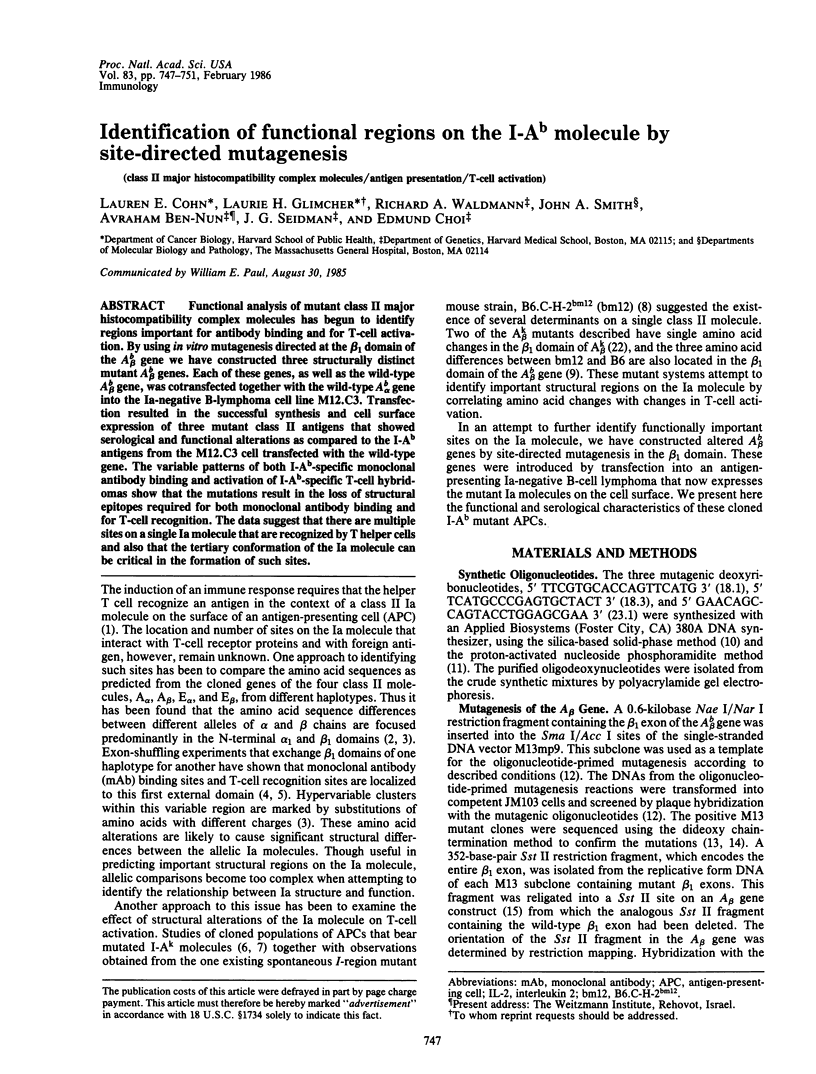
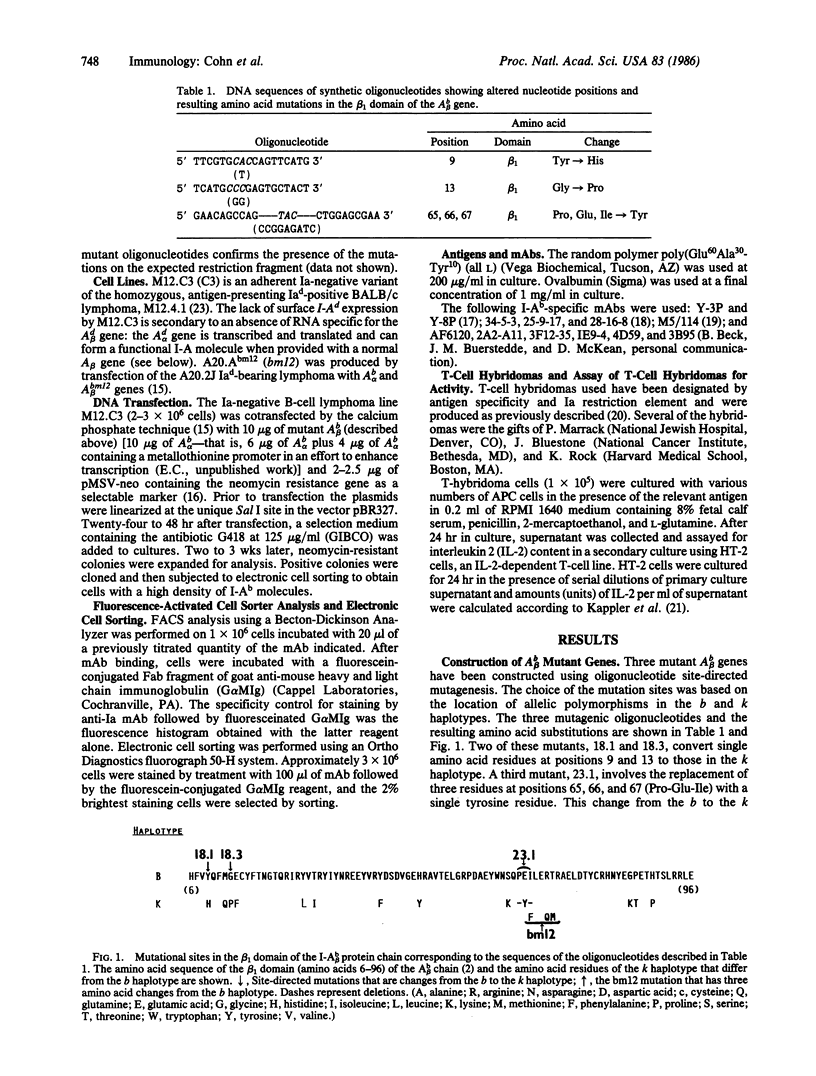
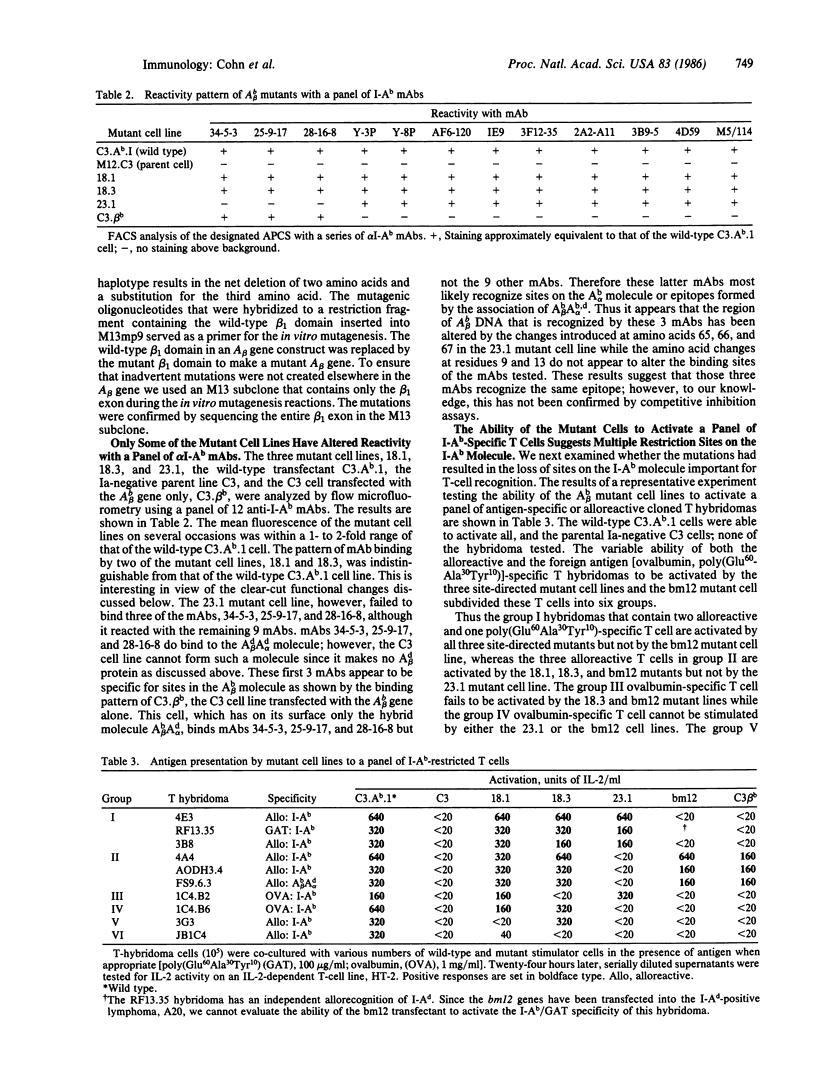
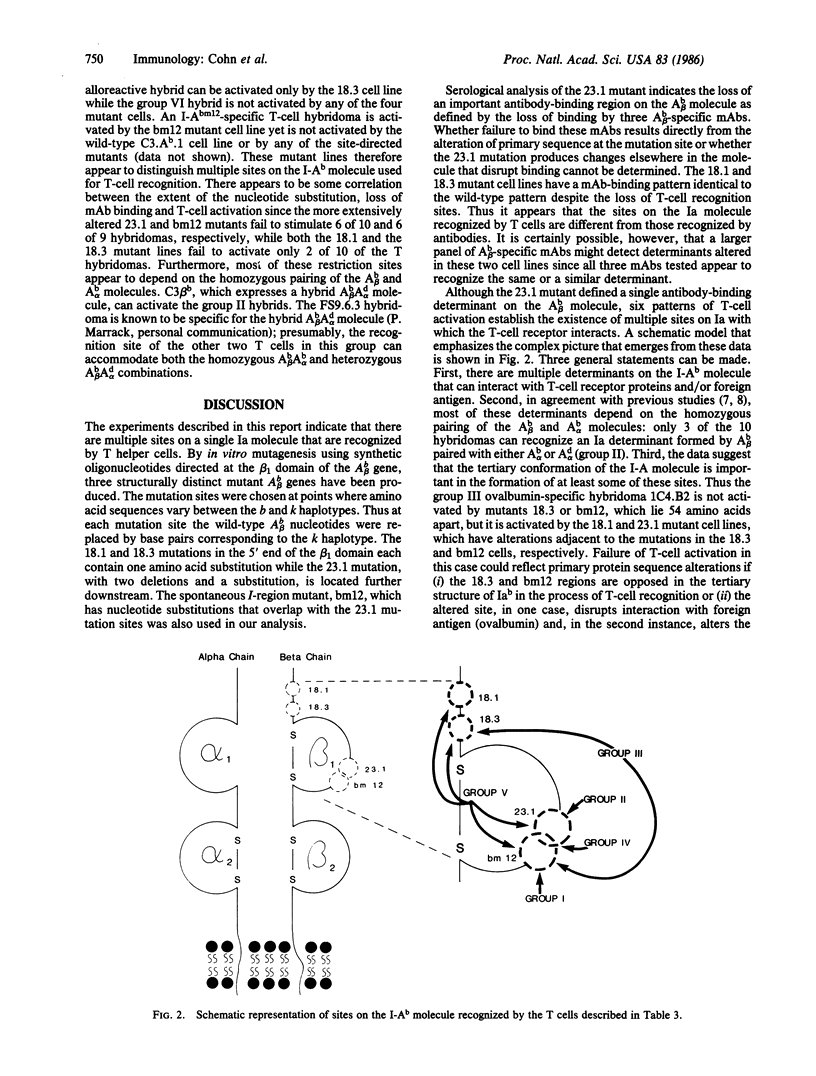
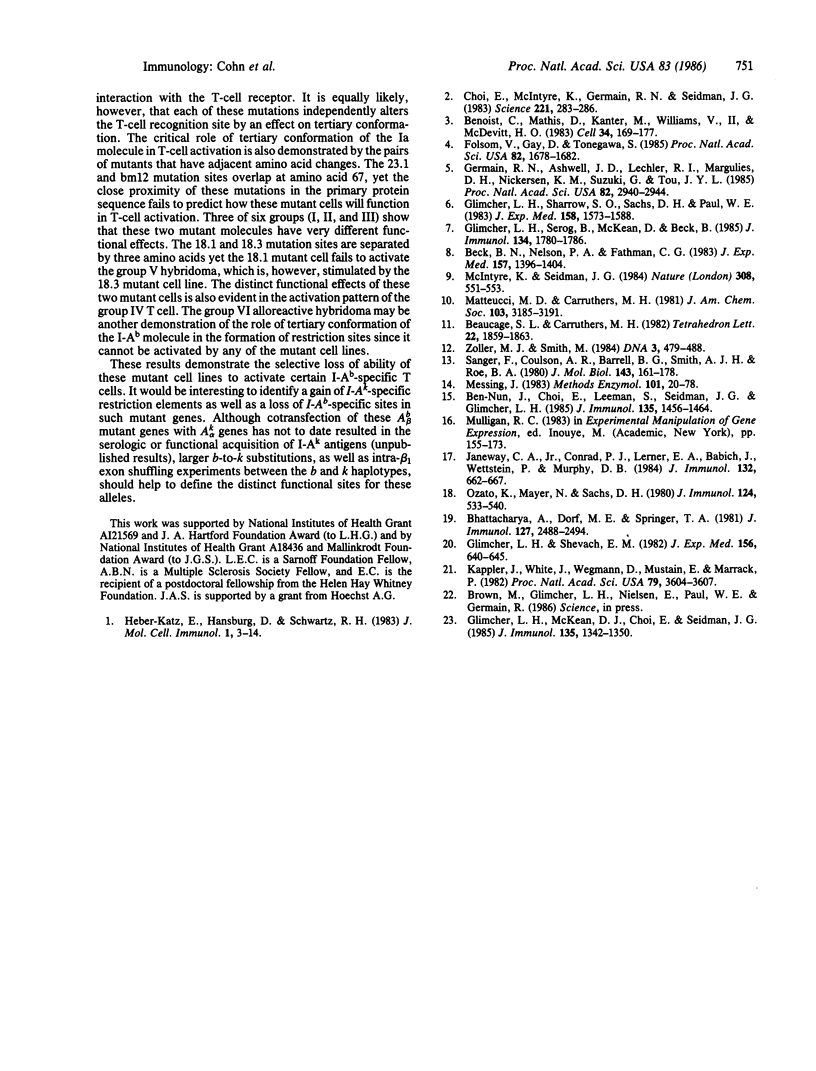
Selected References
These references are in PubMed. This may not be the complete list of references from this article.
- Beck B. N., Nelson P. A., Fathman C. G. The I-Ab mutant B6.C-H-2bm12 allows definition of multiple T cell epitopes on I-A molecules. J Exp Med. 1983 May 1;157(5):1396–1404. doi: 10.1084/jem.157.5.1396. [DOI] [PMC free article] [PubMed] [Google Scholar]
- Ben-Nun A., Choi E., McIntyre K. R., Leeman S. A., McKean D. J., Seidman J. G., Glimcher L. H. DNA-mediated transfer of major histocompatibility class II I-Ab and I-Abm12 genes into B lymphoma cells: molecular and functional analysis of introduced antigens. J Immunol. 1985 Aug;135(2):1456–1464. [PubMed] [Google Scholar]
- Benoist C. O., Mathis D. J., Kanter M. R., Williams V. E., 2nd, McDevitt H. O. Regions of allelic hypervariability in the murine A alpha immune response gene. Cell. 1983 Aug;34(1):169–177. doi: 10.1016/0092-8674(83)90147-2. [DOI] [PubMed] [Google Scholar]
- Berger M., Birx D. L., Wetzler E. M., O'Shea J. J., Brown E. J., Cross A. S. Calcium requirements for increased complement receptor expression during neutrophil activation. J Immunol. 1985 Aug;135(2):1342–1348. [PubMed] [Google Scholar]
- Bhattacharya A., Dorf M. E., Springer T. A. A shared alloantigenic determinant on Ia antigens encoded by the I-A and I-E subregions: evidence for I region gene duplication. J Immunol. 1981 Dec;127(6):2488–2495. [PubMed] [Google Scholar]
- Choi E., McIntyre K., Germain R. N., Seidman J. G. Murine I-A beta chain polymorphism: nucleotide sequences of three allelic I-A beta genes. Science. 1983 Jul 15;221(4607):283–286. doi: 10.1126/science.6407114. [DOI] [PubMed] [Google Scholar]
- Folsom V., Gay D., Tonegawa S. The beta 1 domain of the mouse E beta chain is important for restricted antigen presentation to helper T-cell hybridomas. Proc Natl Acad Sci U S A. 1985 Mar;82(6):1678–1682. doi: 10.1073/pnas.82.6.1678. [DOI] [PMC free article] [PubMed] [Google Scholar]
- Germain R. N., Ashwell J. D., Lechler R. I., Margulies D. H., Nickerson K. M., Suzuki G., Tou J. Y. "Exon-shuffling" maps control of antibody- and T-cell-recognition sites to the NH2-terminal domain of the class II major histocompatibility polypeptide A beta. Proc Natl Acad Sci U S A. 1985 May;82(9):2940–2944. doi: 10.1073/pnas.82.9.2940. [DOI] [PMC free article] [PubMed] [Google Scholar]
- Glimcher L. H., Serog B., McKean D. J., Beck B. N. Evidence that autoreactive T hybridomas recognize multiple epitopes on the I-Ak molecule. J Immunol. 1985 Mar;134(3):1780–1786. [PubMed] [Google Scholar]
- Glimcher L. H., Sharrow S. O., Paul W. E. Serologic and functional characterization of a panel of antigen-presenting cell lines expressing mutant I-A class II molecules. J Exp Med. 1983 Nov 1;158(5):1573–1588. doi: 10.1084/jem.158.5.1573. [DOI] [PMC free article] [PubMed] [Google Scholar]
- Glimcher L. H., Shevach E. M. Production of autoreactive I region-restricted T cell hybridomas. J Exp Med. 1982 Aug 1;156(2):640–645. doi: 10.1084/jem.156.2.640. [DOI] [PMC free article] [PubMed] [Google Scholar]
- Heber-Katz E., Hansburg D., Schwartz R. H. The Ia molecule of the antigen-presenting cell plays a critical role in immune response gene regulation of T cell activation. J Mol Cell Immunol. 1983;1(1):3–18. [PubMed] [Google Scholar]
- Janeway C. A., Jr, Conrad P. J., Lerner E. A., Babich J., Wettstein P., Murphy D. B. Monoclonal antibodies specific for Ia glycoproteins raised by immunization with activated T cells: possible role of T cellbound Ia antigens as targets of immunoregulatory T cells. J Immunol. 1984 Feb;132(2):662–667. [PubMed] [Google Scholar]
- Kappler J., White J., Wegmann D., Mustain E., Marrack P. Antigen presentation by Ia+ B cell hybridomas to H-2-restricted T cell hybridomas. Proc Natl Acad Sci U S A. 1982 Jun;79(11):3604–3607. doi: 10.1073/pnas.79.11.3604. [DOI] [PMC free article] [PubMed] [Google Scholar]
- McIntyre K. R., Seidman J. G. Nucleotide sequence of mutant I-A beta bm12 gene is evidence for genetic exchange between mouse immune response genes. Nature. 1984 Apr 5;308(5959):551–553. doi: 10.1038/308551a0. [DOI] [PubMed] [Google Scholar]
- Messing J. New M13 vectors for cloning. Methods Enzymol. 1983;101:20–78. doi: 10.1016/0076-6879(83)01005-8. [DOI] [PubMed] [Google Scholar]
- Ozato K., Mayer N., Sachs D. H. Hybridoma cell lines secreting monoclonal antibodies to mouse H-2 and Ia antigens. J Immunol. 1980 Feb;124(2):533–540. [PubMed] [Google Scholar]
- Sanger F., Coulson A. R., Barrell B. G., Smith A. J., Roe B. A. Cloning in single-stranded bacteriophage as an aid to rapid DNA sequencing. J Mol Biol. 1980 Oct 25;143(2):161–178. doi: 10.1016/0022-2836(80)90196-5. [DOI] [PubMed] [Google Scholar]
- Zoller M. J., Smith M. Oligonucleotide-directed mutagenesis: a simple method using two oligonucleotide primers and a single-stranded DNA template. DNA. 1984 Dec;3(6):479–488. doi: 10.1089/dna.1.1984.3.479. [DOI] [PubMed] [Google Scholar]


